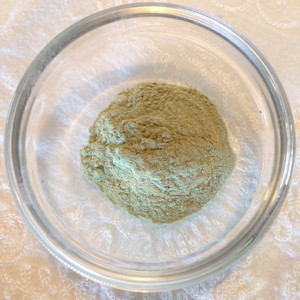Herbal Facial – Extraction – part 5 of 7

This is where the cosmetic clays are really useful!
Most people, in my experience, are used to using these clays for “drawing out toxins”, and indeed they do have a drawing action. However, they are also rich in minerals that can be a benefit to the skin.
My favourite clays are French Green Clay and Rhassoul Clay.
In my experience French Green Clay is very drawing in comparison to Rhassoul clay. French Green Clay contains magnesium, phosphorous silicon, selenium, and copper. It gets its green colour from iron oxides and plant matter that has naturally been broken down into its more component elements.
Rhassoul Clay, also known as Ghassoul Clay, is very rich in magnesium, and also contains silicon, iron, potassium, and other minerals. It is very soothing and has a smooth texture. It is the clay I use for people with sensitive skin.
Some people do use White Cosmetic Clay, Bentonite Clay, or Fullers Earth Clay, but personally I don’t care for them as much and I have concerns about the amount of aluminium that they often contain.
Time to play with mud pie!
Using your clay of choice, mix it with your choice of clean water or hydrosol until it forms a creamy easy to spread consistency. You can also add herbal powders, essential oils, tinctures, and/or infusions. Whatever you add the end result needs to be spreadable because you are going to use it to cover your entire face.
Some ideas to get you started:
aloe powder – great for the anti-aging regimen
rose water (hydrosol) – good for aging skin
seaweed powder – I usually add this to the French Green Clay. Very rich in minerals.
raw honey – wonderful for blemished skin
lavender water – soothing
chickweed – soothing
Depending on the skin type I use clay facial masks in one of two ways.
- Applied to the face and allowed to dry
- Applied to the face and kept moist
The first method, allowing it to dry, is very drawing. This way is drawing and stimulating to the circulation of the skin. However, not everyone should do this. For example if you have Rosacea you will want to avoid this method.
If acne is a problem for you, expect it to get worse before it gets better, because the clay is drawing things to the surface. After that a regular regimen of facials (say once per week) should do wonders for maintaining your complexion.
The second method, keeping it moist, which is done by applying a warm damp cloth over the mask allows the clay to draw more gently but also to release its nutrients and minerals to the skin. This method is better for those with very sensitive skin. The more sensitive your skin is the shorter the amount of time to leave the mask on, at least initially. You can gradually lengthen the time as your skin gets gradually healthier.
Once you have had the clay mask on for the desired time you can gently remove it using a clean wet wash cloth. The cloth will need to be rinsed out several times… this is not a tidy part of the process.
Your skin may be slightly red, and may even tingle, after this step in the facial because you have stimulated circulation to the skin.


Where can I buy green clay
We carry green clay, as do many healthfood stores.
Manuscript is a collective name for texts